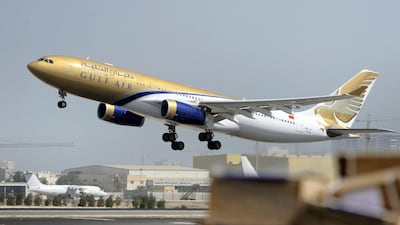Gulf Air, Bahrain’s flag carrier and the oldest airline in the Arabian Gulf, may seek a joint venture with Etihad Airways following a codeshare agreement last month but would stop short of a merger as it strives to become the “boutique carrier of the Middle East”, according to its chief operating officer.
"We wouldn't go as far as [merging with Etihad] because each airline in the region has a very strong DNA, personality and brand, so we are not looking at this sort of partnership," Vincent Coste, Gulf Air's chief commercial officer, told The National.
“They have their strategy and we have ours but we can support each other through an expanded partnership.”
Gulf Air would instead consider a joint venture deal – or joint business agreement as it is known in the aviation industry – with Abu Dhabi’s flag carrier, or any other airlines with which it forms partnerships in future.
“There are different steps in the relationship between airlines – entry level is an 'interline agreement', where you can connect your passengers with their network,” Mr Coste said. “The second level is a codeshare, which is what we have with Etihad, and the ultimate level is a joint business agreement in which the airlines obtain the legal rights to advance cooperation and align their networks and operations in many ways that can be beneficial to both parties.”
Global carriers with JVs in place include United Airlines and Lufthansa Cargo, Air France-KLM and Kenya Airways, and IAG and American Airlines with Chile’s Latam Airlines. Such deals often involve revenue-sharing arrangements and require obtaining anti-trust immunity under competition law - a lengthy process.
Under the codeshare agreement in March, Etihad will place its code on 12 Gulf Air routes across the GCC, North Africa, Europe and Pakistan, while Gulf Air will place its code on 10 Etihad routes in Africa, Australia, Indonesia and the United States.
Gulf Air has codeshares in place with Thai Airways, Royal Air Maroc and others, and forging agreements with new partners is “a very important pillar of our strategy”, Mr Coste said.
The company expects to forge another tie up – most probably with an Indian carrier – in 2019, he added. India has refused to grant additional air travel rights to GCC airlines, curtailing their expansion in a market of almost 1.3 billion people.
Once the dominant airline in the GCC, Gulf Air was outpaced by regional rivals Emirates and Etihad Airways in their quest for major hub status, leading to financial losses that resulted in job and route cuts amid years of restructuring the business.
Last February, Gulf Air launched a five-year growth strategy comprising fleet expansion, a fresh business-class offering and a target to broaden its network with new routes to Asia Pacific and North America. It aims to serve 60 global destinations by 2023 from 47 now, and will launch routes to Malaga in Spain and Salalah in Oman this year, plus New York and others from 2020, Mr Coste said.
He said Gulf Air has no desire to rival its larger neighbours and instead aims to target three niche but reliable markets – business travellers, premium leisure and millennials – and in doing so become the Middle East’s best-known boutique airline.
It is phasing out its fleet of Airbus A330s and over the next two years the Boeing 787 Dreamliner will become its only widebody plane. It has six at present and will take delivery of 10 in total. For narrowbody aircraft it has 12 A320 neos and 17 A321s.
Mr Coste would not disclose loss-narrowing projections for 2019 but pointed to several indicators of revenue growth: Gulf Air’s ticket value increased by 2 per cent year-on-year in the first quarter and capacity by 27 per cent, he said, while overall seat load factor stood at 86 per cent.
“Loss reduction is not our strategy. We want to focus on generating quality revenue, and these indicators are encouraging,” he said.

